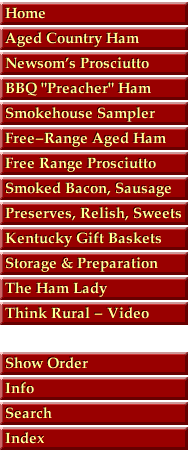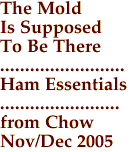 |  | 
  
By Sue Moore
Photography by Kate Lacey
The following contains excerpts from the article in Chow magazine. Sue Moore is the meat forager for Chez Panisse in Berkeley, California. The inspiration for her article began when Alice Waters, the restaurant owner and leader in the natural food movement wanted a ham for Christmas dinner. She did not get a Newsom's ham then, but she located our business and secured our ham for another occasion. There were many telephone conversations to follow.
Ham producer Nancy Newsom and chef/nutritionist Alice Waters met the year before this article at a food source and chefs gathering coordinated through the University of Kentucky in Lexington.
...................................
The history of the country ham is the history of
preservation without refrigeration. Traditionally the
process began in the late fall and winter when the
weather turned cold. The hogs were slaughtered, and
their back legs were rubbed down with a salt-based cure, the exact ingredients of which were often closely guarded family secrets. . . .Many producers use sugar or brown sugar in the mix. . .Sometimes it's called sugar cured, and when people hear 'sugar cured,' they think it's gonna taste sweet, but the greater percentage of the cure, over 50, is salt, and salt is what does the curing. ...
When spring arrived and temperatures began to rise,
the hams were washed of their cure and hung to dry in
the "hanging house." When the time was right, the hams were smoked, then put back up to hang. All this was done to prime the hams for the hot summer months ahead. And a lot of salt was used. ...
Surviving the summer, or the "July sweats" as it's
known, is what gives the ham its deep flavor. As it
hangs, it becomes covered with mold. When the weather heats up, the ham expands and the meat absorbs some of the mold. It's this mold, along with the cure, that gives the meat its character.
"And every ham house has its own mold," according to
Lady Colonel Nancy Newsom Mahaffey, of Princeton,
Kentucky, whose family has been putting up hams in the Virginia style for generations. She earned the title
of Lady Colonel from the state of Kentucky for her
work curing hams. "So when it gets so hot in the summer and I think I just can't stand it one more minute, I say to myself,'Nancy, the hotter the summer, the better the ham."'
Atmospheric conditions dictate most of a ham's
development. When a batch of hams "come up"—that is, when they're washed of their cure and hung to dry—is determined by the weather. How long they hang before they're smoked also varies due to weather conditions. Weather even determines the day to smoke. You can smoke hams on a nice day or a rainy day, but doing so on a real humid day will generate a lot of heat.
"You've gotta be careful," says Mahaffey. "And it's
not all over with once you hang 'em up. Do I need to
pass air over them today or not? There is an intuition
to it. And it all depends on the weather."
. . .With modern heating and refrigeration, hams now can be made yearround. At many facilities they're made four or five times per year, though the majority are still started in the winter because "green" or fresh, uncured hams command the best price. The cure is rubbed on the ham. It's reapplied two weeks later. Then the ham sits on a shelf at 38°F to 40°F for about 40 days. The cure is then washed off, and the ham goes through ten days of between 50°F and 55°F temperatures. After that it goes to the "heated room" for six weeks, where the
temperature is cranked up to 75°F to 90°F. The
procedure simply mimics what used to happen out in the barn. . . .
(Newsom's hams are an ambient cured aged meat, exactly the way they used to be in the barn. There is no heated room in this process. The facility produces only one crop a year. Also, there are no nitrates.)
...............
Like wine, a ham develops nuanced flavors with age.
Mahaffey prefers the "exquisite" flavor of her
15-month-old hams.
"You have to understand something about Southern
cooking: people will cook something and cook it again.
There is no such thing as blanched green beans in the
South. And most people will cook these hams to death.
It's true. I never ate a piece of toast that wasn't burnt until I was an adult."
Do you have to cook these hams to eat them? The USDA remains silent on the subject because no one has ever pushed to have raw country ham sanctioned. The fear is that, if asked, the USDA would not approve it and would require a label saying country hams shouldn't be eaten raw.
. . .Not surprisingly, then, each person seems to have his or her own way of cooking a ham—boiled, steam-baked, fried with or without coffee grounds.
Here's how Mahaffey cooks her hams: First, remove any excess mold by scrubbing the ham with a bristle brush and a vinegar-and-water solution. Then soak the ham overnight in cold water in a cool place. (For hams
more than one year old, soak for two nights, changing
the water once.)
Drain off the soaking water and fill the pot with new
water to cover the ham. The ham should be floating in
the water. Add 1 cup brown sugar and 1/2 cup apple
cider vinegar to the pot and bring to a rolling boil.
Then turn the heat down so that the water just "breaks
a bubble." Cover and cook 15 to 20 minutes per pound.
Turn off the heat, remove the lid from the pot, and
let the ham cool in that water. (Be sure to remove the
lid. If you don't, you'll have, according to Mahaffey,
a "big pile of mush.")
After the ham has cooled, remove it, pat it dry, and
trim off some of the skin while leaving some of the
fat on. Mahaffey likes to serve her hams at room
temperature sliced about 1/8 inch thick.
. . .And a note of caution: "The older the ham, the less
cooking time."
.........................................
The USDA's Food Safety and Inspection Service gets right to the point: "The word ham means pork which comes from the hind leg of a hog." And, "Hams are either ready-to-eat or not."
If only it were that simple. The American country-ham lexicon includes a long list of terms: fully cooked, uncooked, smoked, long cured, bone in, nitrites, nitrates, salt cured, sugar cured, Smithfield, center cut, half ham. Bottom line: the product closest to Italian prosciutto is a country ham cured and aged for so long that its meat is perfectly preserved and requires no cooking at all. According to Nancy Newsom Mahaffey of Col. Bill Newsom's Aged Kentucky Country Ham, a country ham canbe eaten safely without cooking after ten months of aging (other sources say six months). Complicating matters is the fact that some hams labeled for cooking first actually don't need it (the instructions are a protection from regulation). Unnecessary cooking will result in tough, rubbery meat rather than a sweet, melt-in-the-mouth experience.
In colonial America, hogs were the least
destructible, most economical form of animal
protein to raise. Dairy cattle needed smooth, open
fields to thrive, and fowl and sheep were easy prey
for wild animals, whereas hogs were tough and could
forage on marginal farmland while the homesteaders
took time for more pressing work. Slaughtered and
processed in the late fall, hogs became the winter's
food, a longlasting commodity that stored well before
refrigeration and good roads changed the nation's
eating habits.
Dry curing, as opposed to the brine-injected or "city"
cure of most grocery-store ham, is still done in
traditional ways that date back to the mid-1600s. Tidewater Virginia produced the first country hams,
but the practice spread throughout the Southeast. The
cure is made of salt and sometimes sugar for
tenderness, pepper, and nitrites or nitrates which
speed curing and impart a deep pink color. Hams are
usually rubbed with cure twice and kept around 40°F
for a month, during which time the salt preserve
penetrates to the bone. Excess rub is removed, and
then the hams are wrapped and aged at various
temperatures for six months to a year or
even longer. Smoking over a low hardwood fire is
optional. The exact recipes are closely guarded
secrets.
Country hams that require cooking have their own lore.
They sometimes come crusted in benign mold; scrub
that off, then soak the whole ham for up to three days
in several changes of water to draw out extra salt,
and keep scrubbing. Then either steam-bake or simmer. The stove top slow-simmer method calls for water plus anything fun. . .ginger ale, cider, wine, Coca-Cola, vodka.The hard part is finding a vessel big enough for the job of holding the ham plus water to cover it. Oven-steamed ham requires less water but involves lots of temperature changes and clock watching.
Producers are making it easy to try country ham a
little bit at a time by doing some of the cooking
themselves and shipping small quantities of all types.
Don't be put off by the shiny vacuum-sealed packaging
as long as the label says Made in U.S.A.—Nan Chase
|
|
